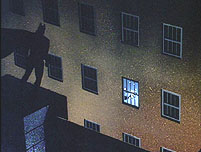 |
Batman:
Witness
Posted:
October
2, 2002
 As
a child, Bruce Wayne witnessed his parents’ murder. That is why he
became Batman.
As
a child, Bruce Wayne witnessed his parents’ murder. That is why he
became Batman.
(Well, yes, we think. That would certainly explain it—if you’re looking for explanations.)
But I notice the word "witness" in there, and its ambiguity. A witness is one who not only sees, but who testifies. He watches events, but events also catch him, and change him, and then they push him forward so that he can inform us about them. A witness becomes part of the scene, but the scene becomes part of him, and through him becomes part of us.
So Bruce Wayne saw his parents’ murder. He was changed by his parents’ murder. And he tells us of their murder, and testifies to the horror and pity of crime and tragedy.
Seize on this fact, for it sheds light on an otherwise curious feature of Batman’s adventures—at least, as they are chronicled in Batman: The Animated Series. For although it’s his name in the title, and it's his exploits being shown, the stories usually hold him at a remove. He undergoes little psychological exploration and virtually no development. As he was in "On Leather Wings," so he is in "Mad Love": a costumed vigilante in an endless fight to protect the innocent from the freaks, criminals and outcasts. Dramatically, he is at the margin of his own show.
BTAS does not really take place in continuity (except for such obvious before-and-after pairings as "Pretty Poison" and "Almost Got ‘Im"), so it would be a mistake to look for development across the series. But even in the isolated stories of "Joker’s Favor," "Two Face," "Catwalk," and "Mad as a Hatter," Batman hardly figures. If the protagonist is the character fighting toward a goal, and the antagonist the one who fights to prevent his reaching it, then the protagonist/antagonist pairs in these stories must be Charlie Collins and the Joker, Harvey Dent and Big Bad Harve, Selena Kyle and Scarface, and Jervis Tetch and his own inner doubts. Where is Batman in the scheme of these stories?
Well, he’s the one who rounds up these perps and perverts before they do too much harm, to themselves or to others. But in the deeper scheme, he is the witness to their stories—the one who discovers and follows them, and arraigns them for us, the audience. For these are crimes and follies, too, and if some don’t deserve pity, none deserve scorn. For it could be any one of us down there in the muck. And once it was Bruce Wayne down there.
Batman is sometimes called a freak, a near-psychopath. No and yes. No, he is a hero constantly balancing himself in the scales of justice. But he judges others because he can testify also to their predicament. And in bringing their stories to us, and merging them with his own, he lets us make judgments too.
So at the end of "Heart of Ice" Batman lingers, watching over Freeze’s cell. For this too is a tragedy, and Batman is our witness to it.
This essay originally appeared in the August edition the Warner Bros. Archive's "Voices." It is reprinted here by permission.